
First and Only Weekly Online Fanzine Devoted to the Life and Works of Edgar Rice Burroughs Since 1996 ~ Over 10,000 Webpages and Webzines in Archive |

First and Only Weekly Online Fanzine Devoted to the Life and Works of Edgar Rice Burroughs Since 1996 ~ Over 10,000 Webpages and Webzines in Archive |
![]()
Virtual
Tour & Scrapbook 18:
TARZAN
OF THE APES
Pulp
Magazines
From
the photo collection of
Bob
"Tarak" Woodley
![]()
"It's a crackerjack!"
![]()
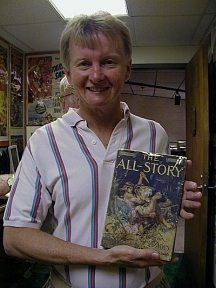
Tarak with All-Story Tarzan
ot the Apes issue
Well, here I am with my ape-man. Whew. Words can hardly describe the feelings I experienced when I had this magical tome in my tawny hands.Tarzan of the Apes. A Romance of the Jungle. A colorful depiction of a white giant with a shock of blackest hair, fighting for his life against another lord of the jungle. His right arm encircles the neck of the savage beast, while his left arm plunges the knife of his long-lost father again and again into the twisting, lunging body of Numa, the lion.
Another man hovers in the background, but we don’t notice him. He is a mere shadow of the wild savage beasts who duel to the death in such splendor. He has usurped the titles and property of another, and will attempt to steal his love as well, but he is as nothing compared to the pure primal lords of the jungle who steal this image.
Which is the perfect image for a perfect story. Which depicts the most famous, most described, most meaningful, most utilized scene in the entire spectrum of the works of Edgar Rice Burroughs. Tarzan on the back of Numa, fighting for his life against this magnificent carnivore. Nothing could be more appropriate for this first depiction of Tarzan of the Apes. Nothing.
Fifty-one years later, in 1963, a young tawny-haired teenager would notice another image of a man fighting with a knife on the back of a lion amidst a colorful, vibrant background of blues and greens and reds, on a forty cent ACE paperback book. He would pick up that book to take a closer look. Turn it over. Look at the back, and read it. Open the front cover and read a bit more. Then he would close the book and look again at that compelling, beautiful, primaeval battle. Something about it called to him; reaching deep within his own being somehow. “Read this!” it seemed to say.
And I did. And was forever changed. As were many of the readers of All-Story when they picked up this October, 1912 issue and took their first look at Tarzan of the Apes. As would be the readers of the World before long. Millions and millions of them; for many decades. And many millions more of moviegoers, and readers of comic strips and books; and in fact in 1999, eighty-seven years later, this character would gross a couple of hundred million dollars in an animated film.
How wonderful it was that the artist/editor/whoever decided to portray this timeless scene in this first impression of Tarzan of the Apes. As if foreknowledge of a nearly unimaginable future guided that choice.
How bold and tall and straight is this wild heroic figure! How fearless he appears as he engages in a battle which would be sheer suicide for any other man. Yet even here, in this first image; before we have opened the pulp, something about him exudes confidence and power and unmatched bravery and skill. One wonders if those first readers sensed this, as I sense it as one who so intimately knows the ape-man. I somehow feel that many of them did.
No wrestling match this; but rather a portrayal of a battle which depicts perhaps the only manner in which a man could possibly defeat a lion; with only that tiny little leap of faith which readers make so easily when they wish; and these first readers would find prose within this story which would make this leap utterly effortless. This one and others. Many were probably skeptical as they viewed this cover, but I’ll bet that they wasted little time in getting to the story. This is certainly a cover which says, “Read this!”
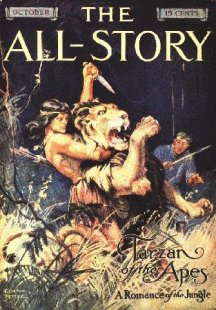 |
It was in that transition period from Summer
to Fall then, back in September, 1912, when these fans of All-Story
sat back in their chairs, or upon benches; or reclined in their beds, under
lights which were perhaps not as user-friendly as our own. Or perhaps they
sat by a window, or upon a porch, with the last waves of summer heat rising
into the air; or the first storms of Fall drenching the streets or yards
or forests which surrounded these readers.
Many lived in England, amidst the moors and castles and traditions. Where Lords still dwelt; and Hooligans; and the dampness intruded into many of their homes. Perhaps some sat by a blazing fire, and gathered their tea and/or pipe and/or skirts, and sat comfortably as they prepared to read this new story by Edgar Rice Burroughs. Most of them had been introduced to this new writer, then Norman Bean, over a period of six months, during the winter and summer months, and they were undoubtedly filled with hope and expectation as they opened this vibrant cover to explore the story which lay within. Most of them certainly expected some good stuff, since the price of this magazine had recently risen astronomically, from ten to fifteen cents. |
Perhaps they opened this pulp with a tinge of extra excitement, since they had probably read the September, 1912 issue of All-Story, which announced the imminent publication of this marvelous story in the next issue. I suppose one has to accept a bit of irony in that the ape-man was first introduced to the world in a magazine which had a very feminine girl and some red roses on its cover. The following images portray what they had seen and read.
|
The first time that the name "Tarzan" appears in print. Announcement of Tarzan of the Apes to appear in next month's issue. 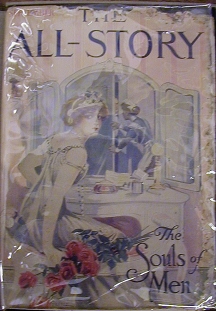
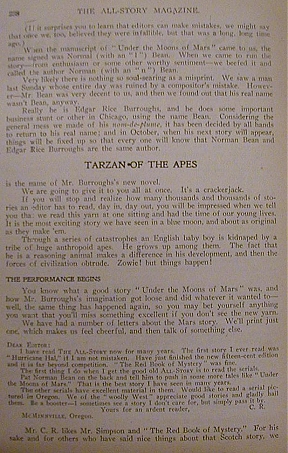 |
ALL-STORY TABLE TALK ~ September
1912
We said last month that we were going to be honest; what follows is going to prove it. It is a confession. (If it surprises you to learn that editors can make mistakes, wemight say that once we too, believed they were infallible, but that was a long , long time ago.) When the manuscript of "Under the Moons of Mars" came to us, the name signed was Normal (with an "l") Bean. When we came to run the story -- from enthusiasm or some other worthy sentiment -- we beefed it and called the author Norman (with an "n") Bean. Very likely there is nothing so soul-searing as a misprint. We saw a man last Sunday whose entire day was ruined by a compositor's mistake. However -- Mr. Bean was very decent to us, and then we found out that his real name wasn't Bean, anyway. Really he is Edgar Rice Burroughs, and he does some important business stunt or other in Chicago, using the name Bean. Consider the general mess we made of his nom-de-plume, it has been decided by all hands to return to his real name; and in October, when his next story will appear, things will be fixed up so that every one will know that Norman Bean and Edgar Rice Burroughs are the same author. TARZAN OF THE APES is the name of Mr. Burroughs' new novel. We are going to give it to you all at once. It's a crackerjack. If you will stop and realize how many thousands and thousands of stories an editor has to read, day in and day out, you will be impressed when we tell you that we read this yarn at one sitting and had the time of our young lives. It is the most exciting story we have seen in a blue moon, and about as original as they make 'em. Through a series of catastrophes an English baby boy is kidnaped by a tribe of huge anthropoid apes. He grows up among them. The fact that he is a reasoning animal makes a difference in his development, and then the forces of civilization obtrude. Zowie! but things happen! THE PERFORMANCE BEGINS
We have had a
number of letters aobut the Mars story. We'll print just one, which makes
us feel cheerful, and then talk of something else.
Dear Editor: I have read The All-Story now for many years. The first story I ever read was "Hurricane Hal," if I am not mistaken. Have just finished the new fifteen-cent edition and it is far beyond competition. "The Red Book of Mystery" was fine. The first thing I do when I get the good old All-Story is to read the serials. Pat Norman Bean on the back and tell him to push in some more tales like "Under the Moons of Mars." That is the best story I have seen in many years. . . . Yours for an ardent reader, C.R. |
“We’re going to give it to you all at once. It’s a crackerjack.”
Thus did the editor of All-Story herald the imminent arrival of this most famous creation of this most beloved writer.All at once. However they came to that decision, it’s the only way this story could be told; and we have this one pulp magazine to look at and hold up and cherish as the complete birth and story of Tarzan of the Apes.

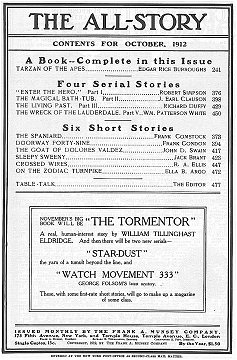
Here is what these readers saw. The cover, and then upon opening the magazine, they read:
A Book — Complete in this Issue
TARZAN OF THE APES ......................... EDGAR RICE BURROUGHS 241
What did they think? As I look at these words in this old pulp magazine I just wonder. This was such a momentous event, but none of these people had any inkling of what they were about to read; or what a phenomenon this story would generate. Such an odd title, and such an unusual cover.I can picture them sitting wherever they might have been, and looking at this page for a few seconds. Then they turned to page 241, and this is what they saw:
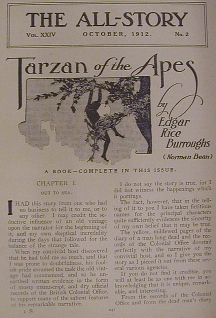
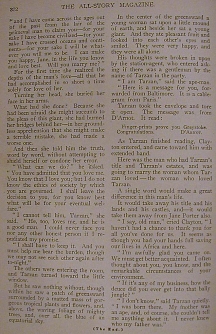
“Tarzan of the Apes
by Edgar Rice Burroughs (Norman Bean)
A BOOK - COMPLETE IN THIS ISSUE
CHAPTER I.
OUT TO SEA.
I had this story from one who had no business to tell it to me, or to any other.........”
And dominating the page is the first art depicting the arboreal ape-man. He is in his element; that unique upper world Edgar Rice Burroughs created solely for Tarzan of the Apes. His bow is slung across his back, and surely he wears the knife of his sire; and his grass rope; though we can’t see them. He is a silhouette figure, not dissimilar to the cover art for the McClurg edition of this story. Black and alone and high above the world we live in. An enigma. A solitary figure whose thoughts and feelings are unknowable to us; except in fleeting glimpses.I just can’t get over looking at this. This is my Tarzan of the Apes, as he was presented almost exactly 88 years ago; perhaps in late August or early September.
This is the image readers looked at as they began to read his story. Readers from all walks of life; for many of whom reading was their greatest excitement. Laborers and soldiers and housewives and secretaries and bankers and farmers. Young and old and male and female. Readers with unique lives and unique pleasures. Each one hoping and expecting a story which would please him or her.
Some had briefly experienced the first-person narration of Norman Bean over a period of several months, and a few had commented how they had greatly enjoyed that story. Now they were about to read a different type of story, and the first published under the name of Edgar Rice Burroughs.
They had never heard of Tarzan of the Apes, except those who might have read the blurb promoting him in the previous issue. They certainly didn’t know what to expect. They were about to meet the ape-man, and Numa, and the mangani. They would follow his story from the cradle to the treetops, and beyond; their minds untinged by film or comics or hype. Just a new story by a new, struggling writer who was trying to feed his family.
But soon they would be absorbed in a tale which was somehow magical. They had seen the marvelous imagination of this writer at work creating wonders almost beyond belief, as seen though the eyes of a hero with a relatively ordinary, if heroic, perspective.
Now they would see this writer turn his imagination inward, towards the human mind and spirit and soul. They would watch him explore the creation of a human being so unique and magnificent that he would take their breath away. They would feel him touch their inner beings and drives and desires, as he drew the fire from our primal ancestors and painted the unforgettable masterpiece which was Tarzan of the Apes.
This was his story, and it was these readers who would judge him. All that has transpired since occurred because of the effect which this story had upon these men and women; girls and boys; who took a look at page 241 of the October, 1912 All-Story and started reading.
Finally they reached page 372, and they read:
“If it’s any of my business, how the deuce did you get into that bally jungle?”
“I don’t know,” said Tarzan quietly. “I was born there. My mother was an ape, and, of course, she couldn’t tell me anything about it. I never knew who my father was.”
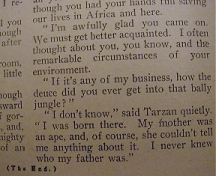
What did they think when they finished this brand-new story about this unusual, thought-provoking, uncivilized beast-man? How was Tarzan perceived by these first readers, uninfluenced by reviews and movies and friends and fans and history?Well, let’s take a look. Let’s re-visit the Winter of 1912, and read the thoughts and feelings and views of those first readers. Those who truly judged Tarzan of the Apes solely as he existed in relation to other works of fiction existing at the time. Here we present the actual comments from those readers of All-Story who sat in daylight or lamplight or firelight and read his wondrous story. They wholly fascinated me. I hope you enjoy them.
| THE ALL-STORY MAGAZINE ~ December 1912
ALL-STORY TABLE TALK
|
THE GODS OF MARS is coming out
as a serial. It will run for several months, and so we all may rest assured
of some extra fine reading stuff by "Battling" Burroughs for some time
to come.
This yarn is a sequel to "Under the Moons of Mars," of never-to-be-forgotten popularity. The author's imagination again riots over the periphery of our terrestrial neighbor. Once more we play with thoats and snarks and so forth, and six-legged gents, and the scientific paraphernalia that can exist nowhere except on Mars where, as we learn from our savants, "they do those things better." Most ever one liked "Under the Moons of Mars," though we remember a couple of chaps who sent us severe reprimands for printing it. We have to beg their indulgence and we we know they will be lenient with us for that we are enthusiastic. So many other folks were that we caught it. May if those chaps who didn't like
Mr. Burrough's first Martian yarn will try his second, they too will get
the hunch that, taking if for better or worse, it is darn good original
stuff. We should by willing to offer a prize to any hombre that could do
better.
16 Kilmartin Avenue Norbury, London, S. W. England Dear Editor: I have just finished reading "Tarzan of the Apes," and of all the engrossing stories I have ever read, I am sure this has been one of the best. It is certainly one of the best I have encountered in THE ALL-STORY during the several years I have been reading the publication. The end of the story would perhaps
be a little disappointing were it not for the fact that it leaves the author
the opening of giving us further glimpses of his gifted imagination. I
am sure I voice the feelings of other readers when I express the hope that
we shall, at some future date, have the pleasure of the continued adventures
of "Tarzan of the Apes."
|
| "Holcombe," Southend-On-Sea, England
Dear Editor: I do not think I can say more than that to convince you that on the whole I have nothing but praise for the magazine. We are allowed to complain a little
as well as to praise, are we not?
Apart from that, however, I think
it is a splendid story and finely
|
Harrow, England,
September 1912 Dear Sir:
I like the change recently made, and the long stories included in your recent numbers, especially "The Souls of Men." I am now reading "Tarzan of the Apes," which promises to be even more enthralling. Accept my congratulations on behalf
of your English readers.
|
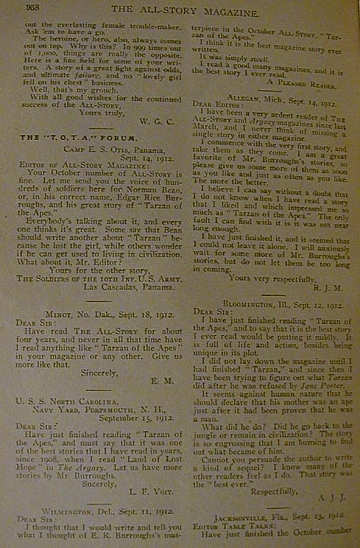 |
THE T.O.T.A FORUM
Camp E.S. Otis, Panama
Everybody's talking about it, and
every one thinks it's great. Some say that Bean should write another about
"Tarzan" because he lost the girl, while others wonder if he can get used
to living in civilization. What about it, Mr. Editor?
Minot, No. Dak. Sept. 18, 1912 Dear Sir: Have read The All-Story for about four years, and never in all that time have I read anything like "Tarzan of the Apes" in your magazine or any other. Give us more like that. Sincerely, E.M. U.S.S. North Carolina Navy Yard, Portsmouth, N.H. ~ September 15, 1912 Dear Sir: Have just finished reading "Tarzan of the Apes," and must say that it was one of the best stories that I have read in years, since 1908, when I read "Land of Lost Hope" in The Argosy. Let us have more stories by Mr. Burroughs. Sincerely L. F. Voit |
| Wilmington, Delaware ~ September
11, 1912
Dear Sir: I thought that I would write and tell you what I thought of E.R. Burroughs's masterpiece in the October All-Story, "Tarzan of the Apes." I think it is the best magazine
story ever written.
Allegan, Mich. ~ Sept. 14, 1912 Dear Editor: I am a great favorite of Mr. Burroughs's stories, so please give us some more of them as soon as you like and just as often as you like. The more the better. I believe I can say without a doubt
that I do not know when
I have just finished it, and it
seemed that I could not leave it
|
Bloomington, Illinois ~ Sept. 12,
1912
Dear Sir: I have just finished reading "Tarzan of the Apes," and to say that it is the best story I ever read would be putting it mildly. It is full of life and action, besides being unique in its plot. I did not lay down the magazine until I had finished "Tarzan," and since then I have been trying to figure out what Tarzan did after he was refused by Jane Porter. It seems against human nature that he should declare that his mother was an ape just after it had been proven that he was a man. What did he do? Did he go back to the jungle or remain in civilization? The story is so engrossing that I am burning to find out what became of him. Cannot you persuade the author to
write a kind of sequel? I know many of the other readers feel as I do.
The story was the "best-ever."
Jacksonville, Fla. ~ Sept. 13, 1912 Editor Table Talks: Have just finished the October number of your ever-pleasing monthly, and must compliment you on Mr. Burroughs' "Tarzan of the Apes." It was one of the best you have printed in months. Keep it up and you will never lose me as a monthly reader. . . . Very respectfully, Bethel |
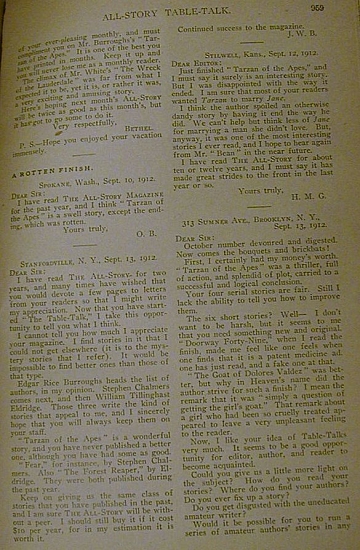 |
Spokane, Wash ~ Sept. 10, 1912
Dear Sir: I have read THE ALL-STORY MAGAZINE for the past year, and I think "Tarzan of the Apes" is a swell story, except the ending, which was rotten. Yours truly, O.B. Standfordville, N.Y. ~ Sept. 13, 1912 Dear Sir: . . . Edgar Rice Burroughs heads the list of authors, in my opinion. Stephen Chalmers comes next, and then William Tillinghast Eldridge. Those three write the kind of stories that appeal to me, and I sincerely hope that you will always keep them on your staff. "Tarzan of the Apes" is a
wonderful story, and you have never published a better one, although you
have had some as good. ... Continued success to the magazine.
Stillwell, Kans. ~ Sept. 12, 1912 Dear Editor: Just finished "Tarzan of the Apes," and I must say it surely is an interesting story. But I was disappointed with the way it ended. I am sure that most of your readers wanted Tarzan to marry Jane. I think the author spoiled an other
wise dandy story by having it end the way he did. We can't help but think
less of Jane for marrying a man she didn't love. But, anyway, it was one
of the most interesting stories I have ever read, and I hope to hear again
from Mr. "Bean" in the near future. ...
313 Sumner Ave., Brooklyn, N.Y. Dear Sir: October number devoured and digested. Now comes the bouquets and brickbats! First, I certainly had my money's
worth. "Tarzan of the Apes" was a thriller, full of action, and
splendid of plot, carried to a successful and logical conclusion. . . .
|
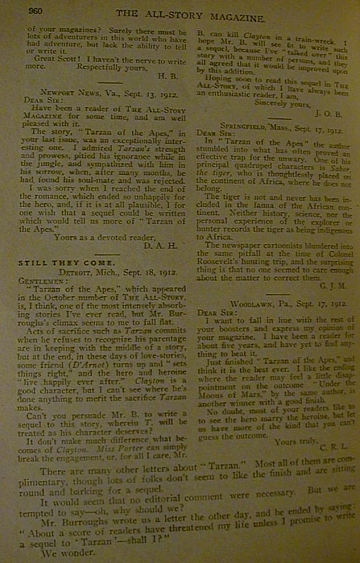 |
Newport News, Va.
Dear Sir: . . . The story, "Tarzan of the Apes," in your last issue, was an exceptionally interesting one. I admired Tarzan's strength and prowess, pitied his ignorance while in the jungle, and sympathized with him in his sorrow, when, after many months, he had found his soul-mate and was rejected. I was sorry when I reached the end
of the romance, which ended so unhappily for the hero, and, if it is at
all plausible, I for one wish that a sequel could be written which would
tell us more of "Tarzan of the Apes."
STILL THEY COME Detroit, Mich. Gentlemen: "Tarzan of the Apes," which appeared in the October number of The All-Story is, I think, one of the most intensely absorbing stories I've ever read, but Mr. Burroughs's climax seems to me to fall flat. Acts of sacrifice such as Tarzan commits when he refuses to recognize his parentage are in keeping with the middle of a story, but at the end, in these days of love-stories, some friend (D'Arnot" turns up and sets things right, and the hero and heroine "live happily ever after." Clayton is a good character, but I can't see where he's done anything to merit the sacrifice Tarzan makes. Can't you persuade Mr. B. to write a sequel to this story, wherein T. will be treated as his character deserves? It don't make much difference what
becomes of Clayton. Miss Porter can simply break the engagement, or, for
all I care, Mr. B. can kill Clayton in a train-wreck. I hope Mr. B. will
see fit to write such a sequel, because I've talked over this story with
a number of persons, and they all agreed that it would be improved upon
by this addition.
|
| Springfield, Mass. ~ Sept.
17, 1912
Dear Sir: In "Tarzan of the Apes" the author stumbled into what has often proved an effective trap for the unwary. One of his principle quadrupled characters is Sabor, the tiger, who is thoughtlessly placed on the continent of Africa where he does not belong. The tiger is not and never has been
included in the
The newspaper cartoonists blundered
into the same pitfall
|
Woodlawn, Pa.
Sept. 17, 1912 Dear Sir: Just finished reading "Tarzan of the Apes," and think it is the best ever. I like the ending where the reader may feel a disappointment on the outcome. "Under the Moons of Mars," by the same author, is another winner with a good finish. No doubt, most of the readers like to see the hero marry the heroine, but let us have more of the kind that you can't guess the outcome. Yours truly,
|
Editor's Final Note:
There are many other letters about "Tarzan." Most all of them are complimentary, though lots of folks don't seem to like the finish and are sitting around and barking for a sequel.It would seem that no editorial comment was necessary. But we are tempted to say - oh, why should we?
Mr. Burroughs wrote us a letter the other day, and he ended by saying: "About a score of readers have threatened my life unless I promise to write a sequel to "Tarzan" - shall I?
We wonder
The Editor
The phrase, “You must have been a beautiful baby; cause baby, look at you now.” comes to mind. And he was. Its abundantly clear from the above comments that this story had a profound effect upon many of those readers 88 years ago. Some liked him more than others; and many didn’t care for that ending; but some are absolutely stunned by the story of Tarzan of the Apes; and they say so.I can see this new magazine growing dirty and tattered as it was passed around among soldiers in Central America, and I can see reader after reader stopping for a few seconds several times, while reading it, to look at the front cover.
They had no idea that a phenomenon had been born. They only knew that this story had somehow reached deep into them and thrilled them and saddened them and moved them unlike any story had ever moved them. Some, like the editor of All-Story couldn’t put it down.
And they wanted more. You can feel the hunger for this character and this writer in their letters. You can sense the power that this story and this creation had over some of them as readers; and the joy they had felt reading this story.
These are critical, thoughtful readers. One doesn’t care for those damn tigers; and perhaps this was the letter which surprised ERB and prompted him to re-evaluate his treatment of African fauna.
It’s rare when we witness the birth of Royalty. But this is it. This story, ALL BY ITSELF, is responsible for the world phenomenon which is Tarzan of the Apes.
Edgar Rice Burroughs may have existed within the body of John Carter when, as a man, he traveled to Barsoom; but when he created his child he created Tarzan of the Apes, and his love for this child permeates the books, irrespective of how much he may have tired of writing them. This was a very special creation. One which transcended stereotypes and politics and social mores and values. One which reached out to those first readers with a splendor and magic which is evident from some of the letters. Tarzan is not for everyone. He marches to his own drum; and some don't care for the beat of the Dum-Dum. However, he called out to many with a voice which was and is in some ways unsurpassed in fiction; and the excitement and magnetism of the ape-man is evident in the words of his first fans. They felt what I felt when I first met him; and so many millions have felt the same thing over nearly a century.
He is my favorite, and he always will be; and I truly felt that I held a treasure when I looked through the first presentation of his story. He is the essence of Edgar Rice Burroughs, to me; and so some others. And certainly to the world.
He is Tarzan of the Apes.
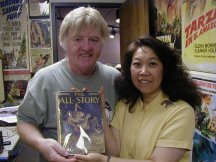
JoN and Dejah with All-Story Tarzan of the Apes |
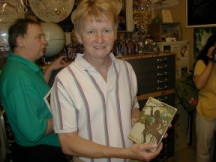
Tarak with 1st Ed. of Tarzan of the Apes Background Laurence and Sue-On |
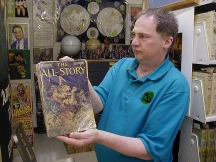
Two Bloody Britishers; one a Lord; the other a Hooligan. |
![]()
|
with hundreds of covers from 1912 to present is featured at: ERBzine 0220 |
![]()
![]()
![]()
Volume
0420

BILL
HILLMAN
Visit
our thousands of other sites at:
BILL
and SUE-ON HILLMAN ECLECTIC STUDIO
All
ERB Images© and Tarzan® are Copyright ERB, Inc.- All Rights Reserved.
All
Original Work © 1996-2010 by Bill Hillman and/or Contributing Authors/Owners